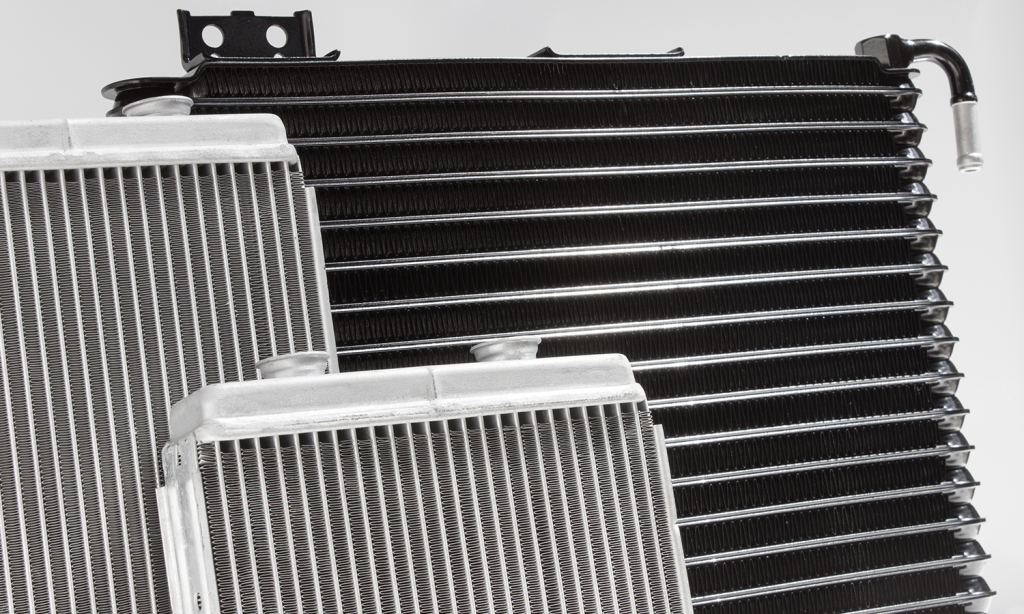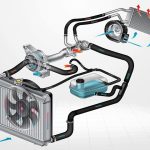Like all the different parts that make up a car, radiators have gone through various stages of development and improvement to make them what they are today. This also means that there are many different types of radiators that each perform differently and are used for different applications.
So just quickly, what is a radiator? A car radiator is a heat exchanger, which, in its simplest form, replaces the hot air inside your engine with cooler air from outside your engine. This helps to manage the temperature of your engine and allows your car to run at its best.

The different types of car radiators
Copper-Brass
Up until 1980, brass radiators were the standard equipment in every car. The structure of the radiator is brass, but the core (the part that works to disperse the heat) is copper. These early radiators were pretty large and bulky, but over time as advancements were made, the weight of copper-brass radiators was reduced by over half!
Although copper-brass radiators are pretty reliable and efficient in doing their job, they are unfortunately very expensive and are susceptible to rust over time.
Cross Flow Radiators
The tanks of a cross-flow radiator are located on both sides of the core. The coolant circulates from the right to the left side of the core.
For vehicles with a low bonnet line or a current little car, this kind of radiator is an excellent choice. The tanks are oriented vertically, whereas the core is oriented horizontally.
On a crossflow radiator, its liquid moves from right to left across its center. The low-pressure sure side of the tank can be used for the radiator cap on this sort of radiator.
When you’re running at high RPMs, this helps relieve some of the pressure on the cap. Crossflow radiators are often available in single, double, as well as triple pass configurations.
As a result, the liquid can be warmed and cooled multiple times. You’ll notice that your body temperature drops by as much as twenty degrees.
The radiator’s ability to separate the fluid that needs cooling from the fluid which has already been cooled allows for the double or triple pass.
The size of a cross-flow radiator is an important consideration. Because they are wider than standard radiators, installing one on a vehicle with an engine upgrade may be problematic. On the other hand, a cross-flow radiator is ideal for vehicles with a low hood line.
The bigger crossflow radiator should disperse greater heat, keeping your cooling network even more functional if you’re worried about that aspect of your car’s design.
Down Flow Radiators
Many vintage cars have a downflow radiator. The core is vertical, the tanks are horizontal. The top tank is filled with coolant. Flow is assisted by pump pressure and gravity. The radiator is under pressure as a result of the airflow.
Through the use of tubes and fins, the coolant dissipates heat, which is subsequently dispersed into the surrounding atmosphere. The bottom tank is where the cooled fluid is stored. In the engine, it is recirculated back to the combustion chambers.
RADIATORS What do they do?
Plastic
Plastic radiators were the solution to the heavyweight and hefty price tags of copper-brass radiators. Plastic radiators make use of an alloy core but utilize plastic end tanks to reduce weight. Although plastic radiators don’t work quite as efficiently as copper-brass ones, the weight and cost savings meant they became the most common type of radiator used by manufacturers.
Aluminium
A problem encountered with plastic radiators was that if they broke, the entire thing would need to be replaced. A solution was needed to avoid having to do this, thus aluminum radiators were adopted. If a specific part of the radiator broke, it could be replaced with an aluminum radiator, instead of needing to replace the whole thing, often at a high cost.
COOLANT
Aluminum radiators also have more benefits on the cooling side of things. They absorb heat a lot faster, meaning that they can basically instantly cool the hot coolant that runs through them. Their efficiency at cooling and dispersing heat is also a lot better than the copper-brass and plastic types.
How does a Radiator Function?
Powered by its various moving parts, a vehicle’s engine burns fuel and generates energy. As a result of all of this energy and activity, the engine can become quite hot.
To avoid engine overheating, it is critical to dissipate that heat from the engine throughout the operation. Helps the engine cool down by dissipating heat that would otherwise be expelled.
Additionally, it comprises a thermostat that regulates the coolant temperature, as well as other cooling components such as water hoses, a fan, and a thermostatic radiator valve.
Radiator hoses transport coolant to the engine via the radiator, where it soaks up extra engine heat before going back to the radiator. When the coolant gets back to the system, thin metal fins dissipate the heat as the hot fluid flows through it.
During this process, cool air enters the cooling system through the grille of the car. The system fan also blows air to help reduce the temperature of the heated coolant and expel hot air from the vehicle when it is not moving, including when you are sitting idle in traffic.
The coolant redistributes throughout the engine after passing through the radiator. Maintaining an ideal operating temperature and preventing engine overheating are the primary goals of this heat exchange cycle.









